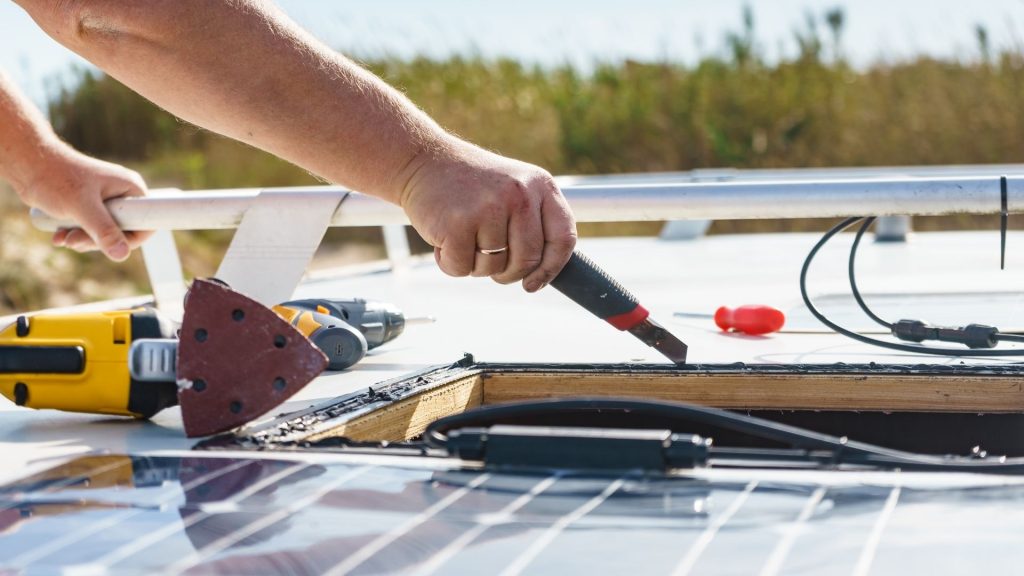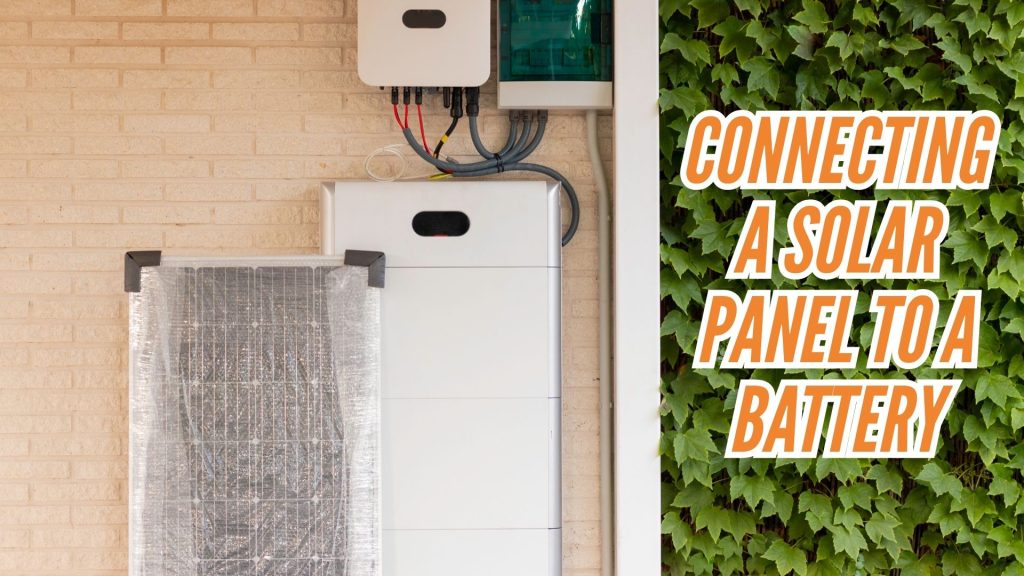Connecting solar panels to a battery is an essential step in setting up an efficient solar power system. This process ensures that energy generated from the sun can be stored and used later, maximizing energy independence and sustainability. Properly wiring a solar panel to a battery, whether for off-grid living or supplemental energy use, requires a clear understanding of the components involved and safe installation practices.
A solar panel system without a battery is limited to providing power only when the sun shines. Batteries store excess energy, allowing you to use electricity during cloudy days or at night. This setup increases energy availability and reliability while supporting energy needs without always relying on the grid. Moreover, incorporating a battery optimizes solar energy utilization and reduces overall energy costs.
Step-by-Step Guide to Connect a Solar Panel to a Battery

1. Preparation and Safety Precautions
Before starting the connection process, ensure safety by wearing insulated gloves and protective eyewear. Verify that you have essential tools such as wire strippers, a multimeter, screwdrivers, and heat shrink tubing.
Confirm that your workspace is dry, well-ventilated, and clear of obstructions to prevent accidents. Always check the polarity of your battery and solar panel to align the positive (+) and negative (−) connections properly.
2. Assemble Required Equipment
Ensure you have the following components:
- Solar Panel: Choose one that suits your energy needs and verify its voltage output matches your battery.
- Battery: Opt for deep-cycle types like lithium-ion or lead-acid for optimal performance.
- Charge Controller: This device is crucial for regulating voltage, preventing overcharging, and ensuring a stable current flow.
- Wiring and Connectors: Use appropriately gauged wires to handle the panel’s current output, with MC4 connectors for secure fittings.
- Inline Fuse or Circuit Breaker: Protects the system from short circuits and overcurrent issues.
3. Position the Solar Panel
Select a location with maximum sun exposure, ideally facing south if located in the Northern Hemisphere, and tilt it at an angle suitable for your latitude. Secure the panel using mounting brackets for stability during adverse weather conditions.
4. Attach the Battery to the Charge Controller
- Connect Positive Terminal: Link the charge controller’s positive output terminal to the battery’s positive terminal.
- Connect Negative Terminal: Attach the negative output from the controller to the battery’s negative terminal.
- Install Inline Fuse: Insert an inline fuse on the positive wire between the charge controller and the battery. This safeguard helps protect against electrical overloads.
5. Connecting the Charge Controller
- Connect Solar Panel to Controller: Attach the positive wire from the solar panel to the charge controller’s positive terminal, and do the same with the negative wire.
- Secure Connections: Tighten all terminal screws to prevent loose connections that could disrupt the current flow or cause safety issues.
6. Final Checks and Testing
- Use a Multimeter: Confirm that all connections are correct by testing voltage output and ensuring no unintended current flow.
- Test the System: Power on the charge controller and monitor the initial charge status to confirm that the battery is receiving power. Ensure the display indicates correct operation, with charging indicators visible.
7. Secure and Protect the Connections
- Apply Heat Shrink Tubing: Cover the exposed connection points with heat shrink tubing for moisture resistance and enhanced durability.
- Secure Wiring: Use cable ties to organize wires neatly and prevent accidental disconnection or wear.
Additional Tips for Optimized Performance
- Maintain Clean Panels: Dust and debris can reduce the efficiency of your solar panel. Regular cleaning ensures peak energy capture.
- Routine Battery Checks: Monitor battery health, checking for overcharging or deep discharging, which can impact its lifespan.
By adhering to these steps, you can ensure a safe, efficient, and durable setup for connecting your solar panel to a battery, making the most of your renewable energy system.
Common Issues and Troubleshooting

Solar power systems can encounter several common issues that may affect their performance. Here’s how to identify and resolve them:
Insufficient Charging or No Charging:
If your solar panel isn’t charging the battery, start by inspecting the panel for visible damage, such as cracks or discoloration, and ensure that there are no obstructions like dirt or shadows that could impede sunlight absorption.
Use a multimeter to test the panel’s voltage output; if it’s below the expected range, the panel might be faulty. Also, verify the connections for any loose wires or corroded terminals, as these can disrupt power flow.
Battery Issues:
Regularly monitor the battery’s voltage and check for physical signs of damage like leaks or bulging. An aging or deeply discharged battery may need replacement. Ensure compatibility between your battery and solar panel to prevent charging inefficiencies. If undercharging is an issue, check your charge controller settings and recalibrate if needed.
Charge Controller Malfunctions:
Faulty charge controllers can limit energy flow to the battery. Inspect the controller for error codes and verify that it is configured correctly for your battery type. If settings are incorrect, adjust them following the manufacturer’s guidelines. A simple reset of the charge controller can sometimes fix minor issues.
Wiring Problems:
Poor or corroded wiring can lead to voltage drops or system failure. Inspect all wiring, tighten connections, and replace damaged wires as necessary. If your system experiences frequent power surges or reverse current, consider using a diode to prevent damage.
Environmental Factors:
Seasonal changes or harsh weather can impact solar efficiency. In extremely high temperatures, panels might underperform due to heat fade, while cold conditions can reduce their output. Regularly clean your panels and adjust their angle to maximize sun exposure throughout the year.
Types of Charge Controllers
Charge controllers play a vital role in protecting your battery and optimizing the efficiency of your solar power system. There are two main types:
PWM (Pulse Width Modulation) Controllers:
- Function: PWM controllers work by maintaining a steady current to the battery, gradually reducing it as the battery reaches full charge. This type is cost-effective and works best for smaller, simpler solar setups.
- Benefits: Affordable and reliable for basic solar applications.
- Limitations: Less efficient than more advanced types, especially in larger solar systems.
MPPT (Maximum Power Point Tracking) Controllers:
- Function: MPPT controllers adjust the input voltage to extract the maximum available power from the solar panel. They then convert this energy to match the battery’s charging voltage.
- Benefits: Up to 30% more efficient than PWM controllers, particularly beneficial in colder climates or for systems where the panel voltage is significantly higher than the battery voltage.
- Drawbacks: Higher initial cost, but typically offset by the increase in efficiency and energy savings.
Choosing the Right Controller:
Selecting between PWM and MPPT depends on the scale of your solar system and energy requirements. For larger systems with higher power needs, MPPT controllers offer better efficiency and overall performance, making them the preferred choice despite their higher price. For smaller, budget-conscious setups, PWM controllers can be sufficient and provide reliable performance.
FAQs
Can I connect a solar panel directly to a battery?
No, direct connections can lead to overcharging and potential damage. A charge controller ensures safe and regulated charging.
What type of battery works best for solar storage?
Deep-cycle batteries, such as lead-acid or lithium-ion, are preferred due to their ability to handle regular charging and discharging.
Conclusion
Connecting a solar panel to a battery is straightforward with the right tools and safety measures. By following the outlined steps, users can efficiently harness solar power, boosting energy sustainability and independence.



